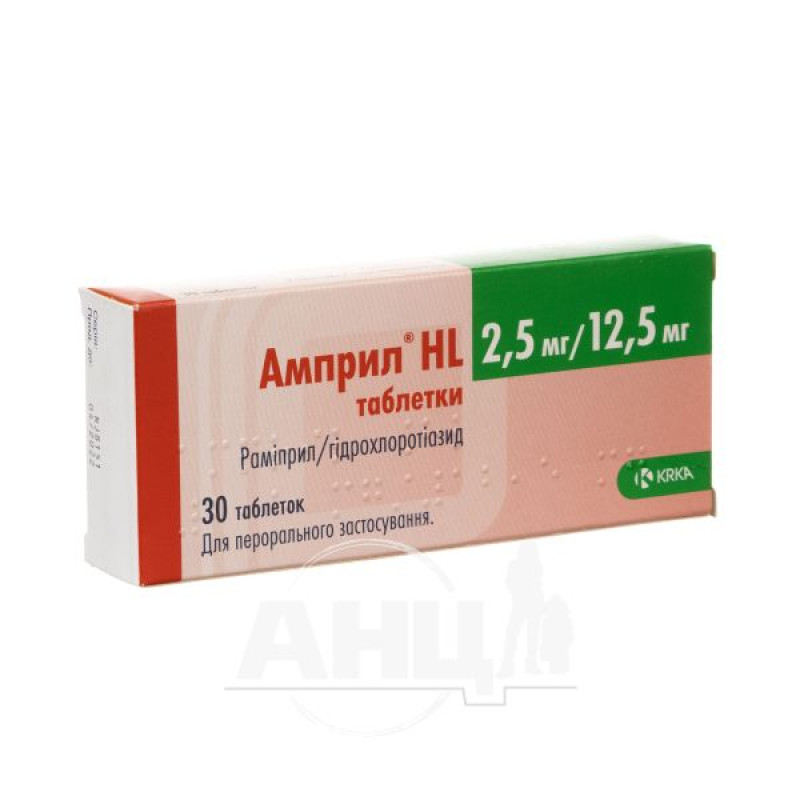Ampril HL tablets 2.5 mg + 12.5 mg blister No. 30

Ampril HL tablets are indicated for the treatment of arterial hypertension. The use of this fixed combination is indicated in patients whose blood pressure is not adequately controlled with ramipril or hydrochlorothiazide monotherapy.
Composition
Active ingredient: 1 tablet contains 2.5 mg of ramipril and 12.5 mg of hydrochlorothiazide;
Excipients: sodium bicarbonate, lactose, croscarmellose sodium, corn starch, sodium stearyl fumarate.
Contraindication
Hypersensitivity to ramipril or other ACE inhibitors, hydrochlorothiazide, other thiazide diuretics, sulfonamides or any other ingredient of the drug
hepatic encephalopathy, severe hepatic impairment; hypotension or hemodynamically unstable state; anuria; history of angioedema; primary hyperaldosteronism; extracorporeal therapy resulting in contact of blood with negatively charged surfaces; significant bilateral renal artery stenosis or stenosis of the artery to a solitary functioning kidney; severe renal insufficiency (creatinine clearance <30 ml/min) in patients not undergoing hemodialysis; clinically significant electrolyte imbalances that may worsen after treatment; symptomatic hyperuricemia (gout); concomitant use with aliskiren-containing products is contraindicated in patients with diabetes mellitus or renal dysfunction (glomerular filtration rate (GFR) <60 ml/min/1.73 m2); pregnant women or women planning to become pregnant; breastfeeding.Method of application
The fixed-dose combination of ramipril and hydrochlorothiazide is recommended only after prior individual dose titration and blood pressure monitoring.
Start treatment with the lowest possible dose. If necessary, the daily dose can be gradually increased over 2-3 weeks until the target blood pressure is reached. The usual maintenance dose is 2.5 mg ramipril and 12.5 mg daily in the morning, and the maximum dose is 5 mg ramipril and 25 mg hydrochlorothiazide daily.
The drug is taken once a day at the same time, preferably in the morning. The drug can be taken before, during and after meals, as food intake does not affect the bioavailability of the drug. The tablet should not be chewed or crushed, but should be swallowed whole with liquid.
Application features
Pregnant women
Contraindicated.
Children
The drug is not recommended for use in children and adolescents under 18 years of age, as there is insufficient data on its efficacy and safety for such patients.
Drivers
Especially at the beginning of treatment, when increasing the dose, replacing the drug, and depending on the individual response to treatment, adverse reactions (low blood pressure, dizziness) may occur. In these cases, you should refrain from driving vehicles and operating machinery for several hours after taking the drug.
Overdose
Depending on the degree of overdose, the following symptoms may occur: excessive peripheral vasodilation (with severe hypotension, shock), impaired consciousness up to coma and cerebral convulsions, paresis, arrhythmia, bradycardia, acute renal failure, electrolyte imbalance and paralytic intestinal obstruction.
Overdose of hydrochlorothiazide may lead to acute urinary retention in patients predisposed to this (e.g. with benign prostatic hyperplasia).
It is necessary to carefully monitor the patient's condition.
Treatment is symptomatic and supportive.
Side effects
The safety profile of the combination of ramipril and hydrochlorothiazide, including adverse reactions, appears in the event of hypotension and/or hypovolemia due to increased diuresis. The active substance ramipril may cause persistent dry cough, and the active substance hydrochlorothiazide may disrupt glucose, lipid and uric acid metabolism. The two active substances have opposite effects on plasma potassium levels. Serious adverse reactions include angioedema or anaphylactic reactions, renal or hepatic impairment, pancreatitis, severe skin reactions and neutropenia/agranulocytosis.
Interaction
Contraindicated combinations.
Extracorporeal treatments that result in contact of blood with negatively charged surfaces, such as dialysis or hemofiltration with certain membranes with high hydraulic permeability (e.g. polyacrylonitrile membranes) and low-density lipoprotein apheresis using dextran sulfate, carry an increased risk of severe anaphylactic reactions. If such treatments are necessary, a decision should be made to use a different type of dialysis membrane or a different class of antihypertensive drugs.
Storage conditions
Store at a temperature not exceeding 30 °C.
Keep out of reach of children.
Shelf life - 2 years.
There are no reviews for this product.
There are no reviews for this product, be the first to leave your review.
No questions about this product, be the first and ask your question.



